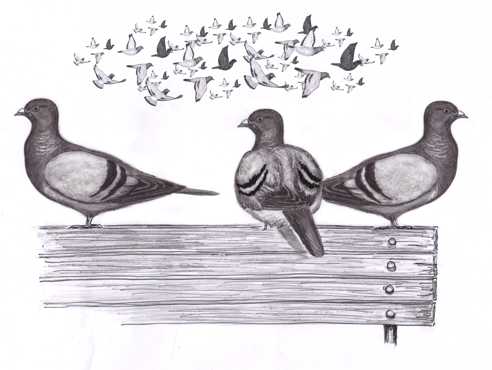
Dear Bird Folks:
Last week I took a few vacation days and went to Boston. While looking out my hotel window, I noticed a flock of pigeons flying above the park across the street. I watched these pigeons for quite a long time as they flew in a tight formation, whirling around back and forth, with apparently no purpose. It was as if the flock had lost its leader. Could this flock have been without a leader or was it simply lost?
-Sharon, Centerville
Let’s See Sharon,
Boston has several outstanding museums, endless shops to explore, centuries of local history, way too yummy restaurants, not to mention Whitey Bulger hiding under every parked car. And you say you spent “quite a long time” watching pigeons fly in circles. Even I take a break from staring at birds once in a while. But I guess I should be supportive, so let’s take a look at your question.
First, no, your pigeons weren’t lost. When you are in a major city and see pigeons hanging out in a park, there is little chance they are lost. These are the birds from the ‘hood and are very much at home. Now, if you were on the top of, say, Mount Washington and saw a flock of pigeons whirling in circles, you would have a case for them being lost. If you did see a flock of pigeons on top of Mount Washington it would probably be made up of entirely male birds, since the males would rather fly in circles than ask for directions, and be proud of it.
Secondly, no, the birds you saw hadn’t lost their leader, because they never had a leader to begin with. Most flocking birds, which appear to move in the effortless synchronization of the Rockettes, amazingly have no leader at all. They don’t even have a shop steward or a bench coach. A flock of birds often moves like a rolling water balloon. It is constantly changing shape, with one edge passing the other. The front bird is not the leader, it just happens to be in the front. Then, as the flock shifts and changes shape, other birds become the front birds. If there is no leader, how does the flock know when to turn or where to go? That’s a tough question to answer. Much like fish in a school, it appears that each individual bird is ultra sensitive to the movements of its fellow flockmates. They are able to respond instantly to the reactions of other birds. Remember, birds don’t flock together to be sociable, they flock together to find food, to find shelter, to survive. Being in a flock has huge advantages. One of the biggest advantages is protection. Many more pairs of eyes are able to detect danger much sooner. If danger is spotted, the flock and the birds that are in it, without a leader and without rehearsal, all react the exact same way. If attacked, a flying flock of birds will ball up, creating a tight formation, that makes it difficult for a hawk to select an individual bird to pick off. The risk of injury prevents the hawk from diving headlong into the middle of the tightened flock. One time I watched a hawk chase a flock of about thirty starlings across the open sky. Suddenly the starlings, without any leader and in perfect unison, plunged straight down towards a telephone pole. The panicked birds hid behind the power transformer and the mass of wires, where the frustrated hawk couldn’t reach them. By responding as a unit, all of the starlings survived, which is good news for me, considering how much expensive suet starlings eat.
The pigeons you saw in Boston Sharon weren’t lost and they don’t need a leader. We can only guess why the flock was flying the way it was on that particular day. More than likely they were either searching for food or water, trying to find a place to roost or perhaps, looking for Whitey Bulger.